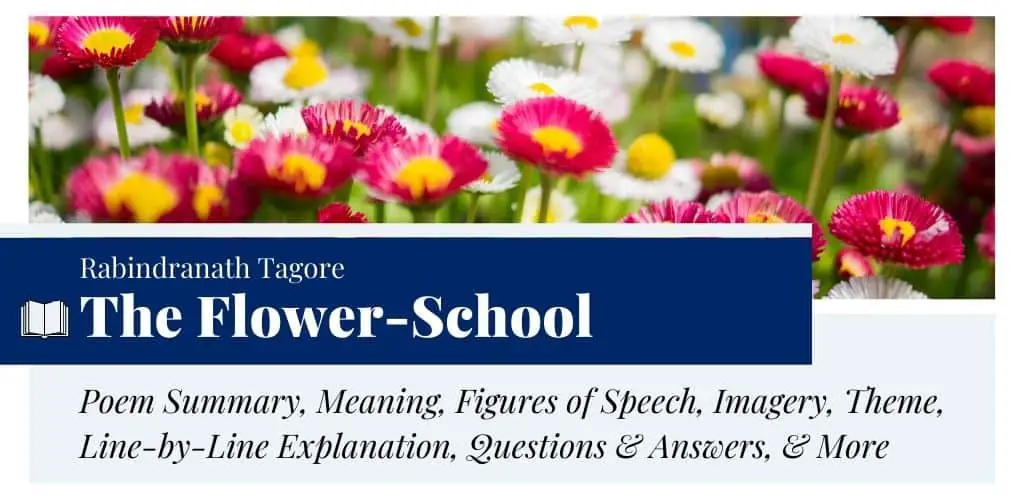The Flower-School by Rabindranath Tagore
“The Flower-School” is a lyrical reflection of a child’s innocence and the relationship between humankind and nature. Tagore beautifully captures a child’s attachment to nature and his mother. The image of the colorful flowers, a metaphor for innocent kids, is enhanced in the context of refreshing monsoons. There is a child-speaker vividly depicting the coming of wild winds, the sound of thunder clouds, and the moves of flowers in the restless gust. She thinks as if their “school” has postponed the classes due to a rainy day. The poem was first published in the collection of poetry entitled The Crescent Moon, originally written in Bengali, was later translated into English by Tagore himself in 1913.
- Read the full text of “The Flower School” below:
The Flower-School by Rabindranath Tagore When storm clouds rumble in the sky and June showers come down, The moist east wind comes marching over the heath to blow its bagpipes among the bamboos. Then crowds of flowers come out of a sudden, from nobody knows where, and dance upon the grass in wild glee. Mother, I really think the flowers go to school underground. They do their lessons with doors shut, and if they want to come out to play before it is time, their master makes them stand in a corner. When the rains come they have their holidays. Branches clash together in the forest, and the leaves rustle in the wild wind, the thunder-clouds clap their giant hands and the flower children rush out in dresses of pink and yellow and white. Do you know, mother, their home is in the sky, where the stars are. Haven't you seen how eager they are to get there? Don't you know why they are in such a hurry? Of course, I can guess to whom they raise their arms: they have their mother as I have my own. - from The Crescent Moon (1913)

Summary
Tagore’s “The Flower-School” vividly depicts a child’s curiosity and the way she observes the surroundings. The child speaks with his mother, who remains a silent listener, and explains her thoughts about flowers. Tagore beautifully implies the restriction and strictness in the child’s school that she thinks are present in the flower’s school. She describes how the flowers go to their school underground to learn how to bloom. It hints at the fact that the child understands the importance of going to school; however, she abhors the lack of freedom and restrictions in the school.
Tagore paints an image of a child with innocent, intriguing eyes observing the dance of flowers in the stormy winds and the beauty that nature holds. The use of different imagery helps readers imagine the picturesque, sublime beauty of nature from the eyes of an innocent child. In the last lines, the child asks a number of questions to her mother, enquiring why the flowers look upward while dancing. Interestingly, she has the answer; she knows to whom they stretch their hands. It is possibly a reference to the almighty or mother nature.
Meaning
The poem is written from the perspective of a child who converses with her mother, expressing her thoughts about flowers that seem attending a school. According to her, the flowers get their holiday when it rains. They raise their heads and stretch their hands playfully to dance with the wild east wind. Through this lyric, Tagore presents the fear of a child attending a school. He also presents how the confinement they feel inside the school. It somehow clips the wings of their imagination that runs free in nature. The “June showers” and “moist east wind” indicate the nourishment nature provides to her children. Furthermore, Tagore specifies how children are curious about everything. They are so filled with creativity and imagination that they can weave fiction in no time with the incidents happening around them.
Structure & Form
“The Flower-School” is a free-verse lyric poem, which indicates that the poem does not have a set rhyme scheme or meter. It consists of ten lines with irregular lengths. All the lines are grouped into one stanza and are not divided into stanzas of the same length. The prosaic, long, and end-stopped lines hint at the child’s thought process. She thinks deeply and spends time wondering about nature.
The sound scheme is soft and rhythmical due to the combination of iambic and anapestic feet. It is written from the first-person point of view, giving this poem a lyrical quality. By using the pronouns “they” and “their”, the child (first-person speaker) talks about flowers. The innocent child has a creative mind. Thus, she sees nature from a different perspective, comparing it to a “school” of flowers.
The child addresses her mother in the fourth line. Her mother is present throughout the poem. She remains silent and listens to her child. This feature makes this poem a dramatic monologue.
Poetic Devices & Figures of Speech
Beautifully seasoned with fascinating figures of speech, “The Flower-School” captures the relationship between mother and daughter, humans and nature, restriction and freedom. Let’s have a look at some important poetic devices used in the poem:
Personification
Tagore uses personification to show the imagination of a small child and her approach towards nature. The child personifies the “storm clouds,” “June showers,” “east wind,” “flowers,” and nature.
- In the second line, the “east wind” is described as marching like soldiers, and it is invested with the ability to blow bagpipes made of bamboo.
- In the third line, the “flowers” are depicted as a “crowd” dancing upon the grass in the wind. The speaker compares them to schoolchildren In the following line.
- In the seventh line, the “thunder-clouds” is personified and described as clapping with their “giant hands.”
- Nature is personified as a “mother” in the last line: “they have their mother as I have my own.”
Metaphor
- There is a metaphor in the phrase, “bagpipes among the bamboos.” The bamboos are compared to the bagpipes of the “east wind.” When the wind blows through the bamboos, it makes a hollow sound imitating the bagpipes. For this reason, Tagore uses this metaphor.
- “The moist east wind comes marching over the heath” contains a metaphor. The poet compares the sound of marching to the sound made by the stormy wind blowing over the heath.
- In “flower children rush out in dresses of pink and yellow and white,” the “dresses” are a metaphor for the colorful petals. The speaker compares the petals to the colorful dresses children wear.
Simile
It occurs in the last line of the poem, “they have their mother as I have my own.” The child compares her mother with the mother of flowers, who is none other than nature. In this way, the speaker describes the deep bond between humans and nature.
Alliteration
The use of alliteration (the repetition of a similar sound at the beginning of neighboring words) creates internal rhymes while reading the poem aloud. Tagore uses this sound device throughout the text. For instance:
- “sky and June showers” (line 1)
- “blow its bagpipes among the bamboos” (line 2)
- “nobody knows”; “grass in wild glee” (line 3)
- “master makes” (line 5)
- “wild wind”; “thunder-clouds clap” (line 7)
Consonance
When the consonant sounds are repeated in a line or phrase, it is called consonance. For instance, there is a repetition of the “k” and “s” consonant sounds in the first line: “When the storm clouds rumble in the sky and June showers come down”. In the second line, there is a recurrence of the “m” sound in the first part, “The moist east wind comes marching over the heath” and the “b” sound in the remaining part, “to blow its bagpipes among the bamboos.” The consonance of the “s” sound in the seventh line (the longest of all) resonates with the rushing sound of the gust. It occurs in “clash,” “forest,” “leaves rustle,” and “rush out.”
Onomatopoeia
Onomatopoeia occurs when a word imitates a sound it describes. Such onomatopoeic words present in the poem include “rumble,” “marching,” “clash,” “rustle,” and “clap.” These words vividly convey the sounds of an approaching storm and its impact on nature.
Polysyndeton
It occurs in “the flower children rush out in dresses of pink and yellow and white.” In this line, the word “and” is repeated to emphasize numerous colors of flowers that appeal to the child’s senses.
Rhetorical Question
This device is used in the ninth line, where the speaker draws her mother’s attention to the eagerness of the flowers. They hurry to meet their mother after their merrymaking is done. The answers are there in the speaker’s questions. That’s why these are rhetorical questions.
Line-by-Line Explanation & Analysis
Lines 1-3
When storm clouds rumble in the sky and June showers come down,
The moist east wind comes marching over the heath to blow its bagpipes among the bamboos.
Then crowds of flowers come out of a sudden, from nobody knows where, and dance upon the grass in wild glee.
Initially written in Bengali, “The Flower-School” was translated into English by Rabindranath Tagore and published in the collection The Crescent Moon. The text of the poem (with actual punctuation used by Tagore) is taken from this collection. In this poem, Tagore describes the beauty of nature from the eyes of a little child. The first three lines provide the cause of the flowers’ appearance above the ground.
The speaker describes the rumbling sound of the “storm clouds” that shroud the sky when June showers are about to occur. These black clouds generally evoke a sense of melancholy in adults and experienced individuals. But, children are different. The moments before the rain starts when the clouds cover the entire sky suddenly in darkness, it paradoxically becomes the brightest time for them. It is because they can come out and enjoy the first drops kissing their soft cheeks as a mother does to her child.
When the east wind (most accurately the south-east monsoon wind) carrying moisture blowing over the heath (an uncultivated open land) passes through the bamboo trees, it makes a shrill hollow sound. The speaker compares this sound with that of the bagpipes. It seems that the bagpipe music coming from the bamboo forest gives a wild call to the flowers. Hearing the tone, the “crowds of flowers” come out and dance upon the grass. It is important to note the personal metaphor in “wild glee.” The term “wild” indicates the untamed nature of the flowers, an extended metaphor for children. Their “glee” or joy is boundless and carefree. Above all, their “spirit” cannot be tamed.
Lines 4-5
Mother, I really think the flowers go to school underground.
They do their lessons with doors shut, and if they want to come out to play before it is time, their master makes them stand in a corner.
In these lines, Tagore indicates that the child is not alone. She converses with her mother about what she sees outside. According to her, the flowers attend their school underground as they cannot be seen in normal time. They raise their heads only when the storm clouds appear, and it rains.
Furthermore, she extends her imagination to create a beautiful story with the elements from her own life. She imagines how they would shut their doors while doing their lesson. If they disobey their “master” and come out to play before it is time, they would get punished just like she would be punished if she disobeys the rules in her school. Then their teacher would make them stand in a corner.
Tagore creates situational irony in these lines. He suggests that even though these flowers are not given classes or attend schools, the child thinks they go to school. This speculation of the speaker draws attention to her own dislike for the restrictions in the school. It also hints at her desire for complete freedom that the flowers enjoy.
Lines 6-7
When the rains come they have their holidays.
Branches clash together in the forest, and the leaves rustle in the wild wind, the thunder-clouds clap their giant hands and the flower children rush out in dresses of pink and yellow and white.
In these lines, Tagore shows how a child comprehends nature. She says that these flowers get their holidays whenever it rains. In the monsoon season, schools also give a holiday to children if it rains. This comparison describes how the child invents a story from her personal experience.
The following line contains a variety of imagery, including kinesthetic, auditory, and visual. Readers can picture/sense how the branches clash, leaves rustle, and thunder-clouds sound from the speaker’s description. The repetition of the word “wild” again hints at a child’s desire for freedom. When the thunder-clouds clap their giant hands, giving a signal to the flowers, they rush out in their pink, yellow and white dresses. These lines indicate children’s glee when they get a holiday. When the school bell rings, the children rush out to play like the flowers.
The following line contains a variety of imagery, including kinesthetic, auditory, and visual. Readers can picture/sense how the branches clash, leaves rustle, and thunder-clouds sound from the speaker’s description. The repetition of the word “wild” again hints at a child’s desire for freedom. When the thunder-clouds clap their giant hands, giving a signal to the flowers, they rush out in their pink, yellow and white dresses. These lines indicate children’s glee when they get a holiday. When the school bell rings, the children rush out to play like the flowers.
Lines 8-10
Do you know, mother, their home is in the sky, where the stars are.
Haven’t you seen how eager they are to get there? Don’t you know why they are in such a hurry?
Of course, I can guess to whom they raise their arms: they have their mother as I have my own.
The concluding lines of “The Flower-School” capture the mother-child conversation. She confidently asks her mother whether she is aware of where the flowers live. Their home is in the sky amidst the stars. When the flowers bloom, their faces always point upward at the sky. It makes the child think that their home can be in the sky. That’s why they always look in that direction. These flowers watch with eager eyes, and they are in a hurry to meet their mother.
Through these lines, Tagore describes the attachment of a child with his mother and the love they have for each other. All these thoughts about flowers going to school may seem unrealistic to others. But she knows her mother would listen to her tales attentively without hesitation. Thus she proudly says, “they have their mother as I have my own.” She compares her mother to that of the flowers, who is none other than mother nature.
Theme
The main theme of Rabindranath Tagore’s poem “The Flower-School” is the relationship between nature and humankind. Another important theme, the mother-child relationship, also takes shape in the last three lines where the child asks questions to his mother and answers herself. This poem is about a child’s imagination about flowers attending an underground school and their innocence. The speaker depicts the jubilation of flowers in the monsoon winds. She says that the sky can be the flowers’ home as she finds them raising their heads above and eagerly looking upward. In this way, Tagore beautifully captures the creative spirit and imaginative powers inside a child’s mind and the relationship between children and nature.
Imagery
In “The Flower-School,” the poet talks about the imagination of a child about flowers going to school and dancing in the wild wind. They become just like children when they get a holiday. These various emotions of the speaker and other images are used in a very elaborated manner, helping every reader picture the scene and sense her feelings. The various types of imagery used in the poem are described below:
- Visual Imagery: The poem begins with a visual image of the storm clouds appearing in the sky and the flowers dancing in the wind. In the seventh line, the poet depicts the impact of the storm on nature visually.
- Auditory Imagery: The rumbling sound of the monsoon clouds is conveyed in the first line, “When storm clouds rumble in the sky.” When the wind blows through the bamboo forest, the sound made in the process is depicted in “blow its bagpipes among the bamboos.” Moreover, the clashing sound of branches, rustling sound of leaves, and rumbling sound (compared to the clapping of giant hands) are conveyed through the use of auditory imagery.
- Kinesthetic Imagery: The movement of the “moist east wind” over the heath is portrayed through kinesthetic imagery. This type of imagery can also be found in “[the flowers] dance upon the grass in wild glee” and “the flower children rush out”.
- Organic Imagery: The speaker conveys her happiness when the storm begins. Her internal emotions are communicated through the use of organic imagery. For instance, the speaker’s love for her mother is conveyed through “they have their mother as I have my own.”
Historical Context
Rabindranath Tagore’s “The Flower-School” was first published in 1913 in the collection, The Crescent Moon. It was part of twelve books translated by Tagore, including Gitanjali. Tagore was the first Indian to win the Nobel Prize in Literature in 1913 for the English translation Song Offerings. He excelled in many fields, including literature, art, and philosophy. Tagore advocated for schooling in an open environment rather than with “doors shut”. To promote a liberating education system unlike an encapsulating system that burdens students, he founded Visva-Bharati University in 1921.
His poem “The Flower-School” also explores the importance of education inspired by nature. It is about a conversation between a child and her mother about flowers. The speaker relates herself with the flower and implicitly craves the freedom they enjoy in nature.
Questions and Answers
The main theme or central idea of Rabindranath Tagore’s poem “The Flower-School” is the relationship between children and nature and mother and child. This poem beautifully depicts how children see their surroundings and also the bond that they have with their mothers. Apart from that, the poem also explores the themes of freedom, innocence, and imagination.
In “The Flower-School,” the child shares a strong bond with her mother. She tells her mother what she thinks about the flowers and asks her some interesting questions about them. In the last few lines of the poem, she indicates her closeness to her mother by saying, “they have their mother as I have my own.” In this way, Tagore signifies the importance of a mother in a child’s life as well as other living beings of nature, such as flowers.
The title of the poem signifies the school or institution of flowers. It is a symbol of nature. According to the speaker, the flowers’ school is underground, and when they get a holiday, they raise their heads above. Only then can they be noticed. In this way, the speaker’s idea revolves around the flowers and their symbolic school. That’s why Tagore used this title.
The flowers raise their arms to the sky to embrace their mother just like the speaker does.
In normal times, the flower cannot be noticed in the thick grass. When the storm arrives, they appear in the scene. For this reason, the speaker thinks they might go to school underground.
According to the speaker, the flower school is located underground. The flowers do their lessons with the doors shut. Actually, the school is an indirect reference to nature.
The speaker vividly describes the storm. She depicts how the storm clouds rumble in the sky before June showers come. The moist east wind starts to blow, making a sound among the bamboos. When the storm intensifies, tree branches clash in the forest, leaves making rustling sounds along with the rumbling of clouds. Then, the flowers rush out and dance upon the grass.
Tagore’s “The Flower-School” is a beautiful free-verse lyric poem consisting of ten lines. There is no regular rhyme scheme or meter. Besides, the presence of a mute listener makes this poem an example of a dramatic monologue.
The moral of the poem is that like the speaker has her mother, every living creature has their mother, including the flowers. Mother nature is always there to protect and nourish her children.
The tone of the poem is joyous, innocent, and imaginative. It reflects the jubilance of the child when the storm comes. The dancing flowers in the field and the various sounds made by the east wind fills her heart with happiness. It is reflected in the poem’s tone.
Similar Poems about Flowers and Mother-Child Relationship
- “Song of the Flower” by Kahlil Gibran — This poem describes a flower’s activities throughout the day.
- “The Flower” by Alfred Lord Tennyson — This metaphorical poem is about personal achievements and novel creations.
- “Flower on the Road” by Chitra Padmanabhan — This poem is about the conversation of two springtime flowers.
- “Fear” by Gabriela Mistral — This poem is about a mother’s fear of losing touch with her daughter when she grows up.
External Resources
- Check Out Greatest Works of Rabindranath Tagore (Deluxe Hardbound Edition) — A compilation of Tagore’s literary masterpieces, this collection includes his incredible short stories, his most lauded Gitanjali, and much more.
- Full text of The Crescent Moon (1913) — Explore more poems from this collection focusing on the love in a mother-child relationship and its development.
- Biography of Rabindranath Tagore — Read this short biographical sketch of Tagore.
- About Rabindranath Tagore — Learn more about the poet’s life and explore some of his well-known poems.



